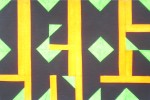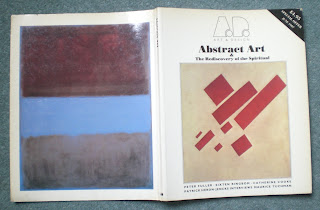The photo-realist paintings of John Salt have something approaching the miraculous about them. Could they really be paintings? Pictures of photographs of cars, made with airbrush, they look untouched by human hands.
 |
| Tree 2001, Casin on linen, 109 x 166 cm, Tellenbach Collection, Switzerland, Image courtesy,of Ikon gallery | |
In the Greek Orthodox tradition
acheiropoieta is the name given to icons not made by human hands. They were allegedly painted by saints, or they appeared miraculously like Veronica's Veil or the Turin shroud. Maybe the images were made of the salt from Jesus' sweat.
But these are no icons, though my eye was conned from time to time into thinking that I was looking at very large photographs rather than paintings. In some senses they are not even images, the matter of fact way in which they are produced and presented, renders them artless, real, objects, to be viewed but not worshipped. And in that they are
also images, they are images of images, the subject matter of which is artless, found, material as opposed to image in the sense of advertisement, shiny gleaming mirror. Other photo-realists seem more interested in images of this kind.
Ikon Gallery Birmingham is showing
work by John Salt until 17 July 2011. I wandered through the two rooms of paintings, 18 in all, spanning 42 years of Salt's artistic output. Not wishing to be impressed (my mission, you may remember, is to view
abstract paintings outside of London), I found myself confronted by a body of work that I was hugely impressed by.
I lingered longest on the 2001 painting
Tree, a solitary vehicle, parked outside a disused store, next to a weedy self-seeded tree, the long shadows suggesting evening or morning.I feel it should be evening symbolically, but seeing how the windscreen is condensed it looks like it may be morning. The shadows emphasise the whereabouts of the cables running up the side of the building and bring attention to the puny tree, projecting a larger than life image of it onto the façade of the building, rather like the projected image of a photograph onto a large canvas, the standard technique for drawing in photo-realist art. The car and the store are a similar colour, terracotta, or rust. I think it highly unlikely that Salt is interested in the symbolic or metaphoric elements in the piece, and maybe these also are projections, but I find it difficult not to see in the terracotta, a symbol of rust and decay, also hinted at in the parked or abandoned car. And I find it difficult not to see in the tree at least a gesture of hope, however futile. I feel sure that this is not the content of the picture as far as the artist is concerned. However, I think the NLP mantra 'the meaning of a communication is the response you receive rather than the intention you had for it' applies here.
I found I could also interpret the painting in abstract '
colour-field' terms, enjoying the large expanse of orange, framed above by the light blue band of sky, and below by the darker blue/grey of the tarmac. Then becoming aware of the lemon yellow rectangle on the right hand edge, echoed by the adjacent dark grey or black rectangle of the door, within which is a cut-out of white. At the opposite side, there are similar rectangles in almost complementary colours of blue and lilac. In this reading of the painting the car plays almost no role at all. I realise that here I may have been compensating for the abstract paintings I did not find!
There are 18 paintings on view, shown more or less in chronological order, the first room with earlier work, paintings with images taken from catalogues, close-up cars, monochromes in red like
Bride 1969, or grey like
Sports Wagon 1969, the open door or window creating a frame through which to view the interior, and then the car wrecks of the early 70s:
Falcon (Patchwork Surface) 1971,
Desert Wreck, 1972;
Pontiac with Tree Trunk, 1973. The second room has the more recent works, from the eighties to the present day, vehicles now more abandoned than wrecked, and shown in landscapes, usually a car or caravan, in its immediate surroundings.
At first I was frustrated at being unable to find much evidence of paint being worked or the artist's touch. I thought I had found actual brush-strokes in
Falcon (Patchwork Surface). Did I have the impression here that the artist actually enjoyed painting the surface? Then, I realised that the the surface being worked was the car body, with spray-painted graffiti. Those painted gestures looked like they had been enjoyed! And then photographed and then painted, or rather airbrushed. I attempted to inspect the canvas edges for evidence of painterliness, only to be thwarted by the aluminium frames, tight to the stretcher.
Then, once I had resolved to stop messing about looking far what wasn't there and to enjoy the work for what it was, the first thing I noticed was the calm. Galleries are not noisy places, but these works seemed to elicit a quietness that was more than gallery quiet alone. I think it was my emotional state, rather than the physical environment. The paintings are still, still lives in a way, yet they are also
memento mori, or as Dieter Roelstraete says in the gallery booklet "that type of still life that is much more eloquently rendered as
nature morte". The Car not as status symbol,shiny and triumphant, but as wrecked, decaying, lonely or abandoned.
Although, according to the booklet, Salt claims not to be offering any social comment I agree with Roelstraete that it is difficult not to find here a comment on capitalism and its future. What I don't find is anything about imagined alternatives. I think I read somewhere in
Zizek the criticism that we find it easier to imagine the destruction of the planet than we do to imagine a future alternative to global capitalism.
(John Salt, curated by Jonathan Watkins and Diana Stevenson, is showing at Ikon Gallery, Birmingham, UK, until 17 July 2011)











